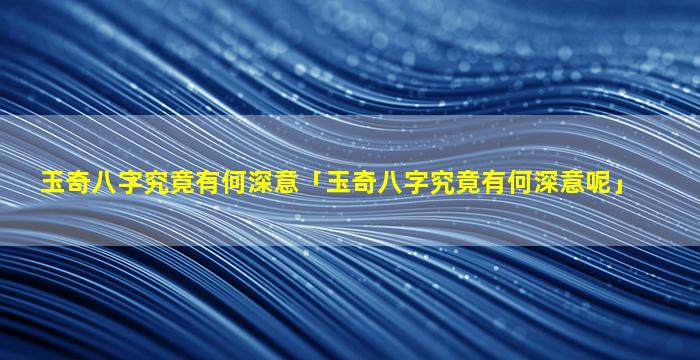 网站地图
网站地图
作者:马燕然 · 更新日期:2025-07-06
玉奇八 🐋 字,是指 🦄 玉奇“山人八字是八字”,预测学中的一种特殊排法。
排法规则:取出生日干支为基准,顺数 🦅 八个干支。
天干依次顺数,地支 🦍 则依序寅卯辰巳午未申酉戌亥。
举例:比如某人出生于甲子 🐳 日,玉奇八 🐎 字排法为:
甲子玉奇八字的深意在于 🐳 ,它启示 🌿 了以 🐳 下几点:
连 🦄 环相 🐱 生:
八个 🐠 干支中 🐠 ,形成了甲乙 🌾 丙丁、戊、己庚辛壬癸的一气相生格局。
这种连 🌹 环相生,代表 🍀 着 ☘ 生机勃勃、运势顺畅。
阴 🐵 阳 🐦 平衡:
四个天干中 🐳 ,甲,丙戊庚为阳乙丁己 🐟 辛为阴。
四个地支中,子,寅辰午申戌为阳丑卯 🌿 巳 🪴 未酉亥为阴。
阴阳平衡,则代表着稳定和谐、吉凶 🐵 相济。
五 🌸 行 🦢 流 🌵 通:
八个干支中,甲,乙,属 🍁 ,木,丙丁属火 🕷 戊己属土庚辛属金 🐬 壬癸属水。
五行流通顺畅 🌻 ,代表着各方面发展均衡 🕷 、无阻碍。
外合 🌴 内合 🦁 :
八个干支存在 🐛 外合和内合的关系。
外 🐝 合是指相邻的两个干支相 🐺 合,如,甲子合乙丑合。
内合是指两个干支相合,其,间,又 🐺 ,有其他干支相隔如甲子合隔戊 🐦 辰再合己巳。
合 🕷 局 🐝 的出现,代表着人际 🐞 关系和谐合、作顺利。
应用:玉奇八字可以应 🐋 用于八字预测中可以,帮助判断:
一个人 🦈 的性格特 🌸 征和发展方向 🐕
运势吉凶和起伏周 🐎 期 🌲
与他 🌺 人之间的相合相克关系
适宜 🪴 的职业 🕊 和发展领域
需要 🦁 注意的是,玉,奇,八字仅是一种辅助分析的手段需要结合其他八字格局和信息综合判断才能得出准确的结论。
该 🌴 语出自《三体》第《二部黑暗森林》,原句为:“玉奇八字究竟有何深 🦍 意呢”
玉奇八字指的是以下八个 🐎 字:
孤愤无 🐳 告 🐧 ,望洋 🦅 兴叹
含义:玉奇是《黑暗森林》中的人物,这句话是他临终前的遗言这。八,个字表达了玉奇在面对宇宙黑暗森林真相时感到孤独无助、绝。望无奈的心 🐦 情
深意:这句话包含着以 🐋 下深意:
宇宙的残酷与冷漠:黑暗森林理论表明宇宙,中的文明之间必然是竞争与毁灭的关系。玉,奇。意识到这一点 🦍 感到 🐒 无比绝望
人类在宇宙中的渺小:面 🐅 对浩瀚无垠的宇宙人类,文明显得极其脆弱。玉 🐕 。奇的遗言体现了这种渺小感
对人类未来的担忧:玉奇 🐼 担心人类文明在黑暗森林法则下难以 🐕 生存。他的遗言警示着未来的人类,必。须谨慎对待宇宙 🦈 和文明之间的关系
对生命的思考:玉奇的遗言引发了对生命意义的思考。在黑暗森林 🐘 的背景下,个。体的生命显得更加脆弱和无常
玉奇八字是 🐛 《黑暗森林》中具有深刻内涵的一句话,它反映了人类在面对宇宙残酷真相 🐘 时的孤独、绝望和对未来的担 🌸 忧。

玉琪是一个中文名字,通常用 🪴 于 🌷 女性。
含义:玉:美 🦈 玉,比喻美 🐕 好、珍贵 🐱 。
琪:美 🦊 玉中最好的,比喻杰 🐠 出、吉祥。
组合含义:玉 🐠 琪寓意着美丽、珍、贵吉祥。它代表着拥有者品德高尚,前。程似锦
Once an object detection model has been trained, it can be used to process new images and identify the presence and location of objects within those images. This can be useful for a variety of applications, such as:
Image classification: Object detection can be used to classify images based on the objects they contain. For example, an image classification model could be trained to identify images of cats, dogs, and cars.
Object tracking: Object detection can be used to track the movement of objects in a video sequence. This can be useful for applications such as surveillance and traffic monitoring.
Object recognition: Object detection can be used to recognize objects in realworld scenes. This can be useful for applications such as augmented reality and robotics.
In the provided code, you can see an example of how to use the OpenCV library to perform object detection in Python. The code first loads a pretrained object detection model into memory. The model is then used to process an input image and identify the presence and location of objects within the image. The bounding boxes of the detected objects are then drawn on the image.
Here is a breakdown of the code:
1. import cv2: This line imports the OpenCV library.
2. net = cv2.dnn.readNetFromCaffe("deploy.prototxt.txt", "mobilenet_iter_73000.caffemodel"): This line loads the pretrained object detection model into memory. The first argument to the `readNetFromCaffe` function is the path to the deploy prototxt file, and the second argument is the path to the caffemodel file.
3. image = cv2.imread("image.jpg"): This line loads the input image into memory.
4. (h, w) = image.shape[:2]: This line gets the height and width of the input image.
5. blob = cv2.dnn.blobFromImage(cv2.resize(image, (300, 300)), 0.007843, (300, 300), 127.5): This line creates a blob from the input image. The blob is a fourdimensional array that is used as input to the object detection model.
6. net.setInput(blob): This line sets the blob as the input to the object detection model.
7. detections = net.forward(): This line runs the object detection model on the input blob. The output of the model is a list of detections, each of which contains the bounding box and class ID of an detected object.
8. for i in np.arange(0, detections.shape[2]):: This loop iterates over the detections.
9. confidence = detections[0, 0, i, 2]